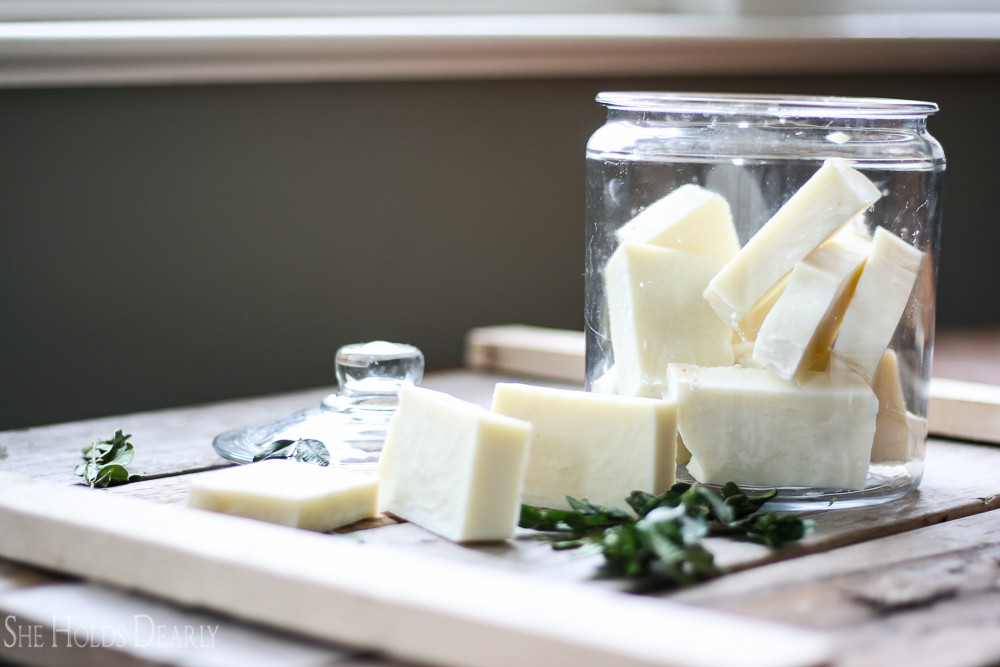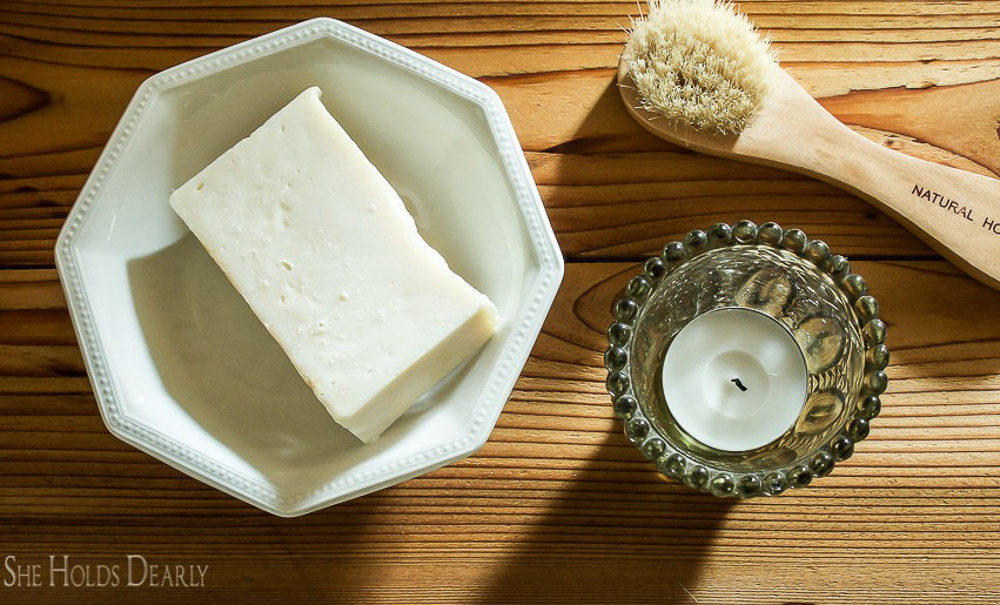Homemade Soap for the Farmhouse
Originally, I got into soap making because I love to know how to make things.
Its interesting, its empowering.
Then, I kept making soap to save money.
Now, I make it because I cannot find a soap that I love more my Homemade Soap for the Farmhouse.
Pure and simple.
This is the soap that dreams are made of. I’m not kidding.
Three ingredients, two if you don’t count water.

Its creamy and all natural, so family members with sensitive skin can use it. We use it instead of shaving cream, shampoo and face wash. I have washed dishes with it for years and even made dishwasher soap, laundry soap and stain remover, too.
And, of course, I am always giving it away as gifts.
It is my go-to, all in one, farmhouse soap. Also, known as castile soap.

Soap making is not as difficult as some people think, its all about exact measurements and temperatures.
It is also not as easy as some people think it is. The lye is a fairly “dangerous” substance and getting the timing or quantities wrong will result in a failed batch of soap.
I really don’t know how those pioneer girls did it!!

This post contains affiliate links for your convenience. Click here to read a full disclosure.

Homemade Soap for the Farmhouse
Ok, so let’s get started.
You will need just three ingredients, one hour and some supplies.
One batch makes about thirty bars. But, they won’t be ready to use for two weeks, so plan accordingly.
Farmhouse Soap Ingredients:
52 ounces Olive Oil (about seven cups, mine is from Costco)
20 ounces Cold Water
Soap Making Supplies:
(If you have the time and not the money, you can find all of these things at yard sales. That is what I did back when I started making soap.)
- Newspaper or something to put down on the counters to protect them
- Kitchen scale
- 2 plastic cups (I use Solo cups) or pitchers
- Small stainless steel pot
- Large stainless steel pot
Note: You must use stainless steel or glass pots, the lye will react with any other metals and the soap will not turn out. If you are getting your pots second hand you can test them by holding a magnet up to them. Stainless steel is magnetic, but aluminum is not.
- Immersion blender
- 2 thermometers (one for oil, one for lye)
- Large plastic spatula
- Large plastic spoon
- Mold, you can also just use a rubbermaid tote, the shoe box size
- Liner for mold if using a wooden mold or you can just line the mold with plastic wrap instead
- Dishwashing gloves, long sleeved shirt, closed toe shoes
- Optional- goggles, the fumes from the lye can irritate your eyes
This is the book I use, but you don’t need it. If all you want to make is my Homemade Soap for the Farmhouse, then this post will do the trick.
Important Notes:
Once you have used these items for soap making you are not supposed to ever use them for food prep again. The lye is a very caustic chemical that should not be ingested, even a little.
You will not want to get the lye on your skin either, it can give you a chemical burn. For this reason, I don’t let my kids handle any part of the processes that involve lye.
However, if you do get lye on yourself, you can splash white vinegar on your skin to neutralize it or just wash with soap and water really well.
Once the whole chemical reaction called “saponification” takes place, the lye becomes non-toxic and instead transforms into an excellent remover of dirt.
A very good quality in soap, don’t you agree?
Homemade Soap Instructions:
- Dress appropriately, see above, and cover the counter with paper.
- Place your plastic measuring cup or pitcher on the scale and zero it out.
- Wear gloves and weigh out EXACTLY 7 ounces of lye in your plastic cup/pitcher. Soap making is an exact science. I repeat, be exact.
- Pour the lye into the small stainless steel pot.
- Place the second (non-lye) plastic cup/pitcher on the scale and zero it out again.
- Weigh EXACTLY 20 ounces of cold water in your plastic cup/pitcher.
- Pour the water into the pot containing the lye. Be careful not to splash. Don’t make the mistake of adding the lye to the water. The solution will instantly get very hot and start fuming. At this point, I set my lye pot out on my back porch to cool down. Use your plastic mixing spoon to dissolve the lye into the water.
- Now, take your plastic cup/ pitcher that you used for the water and zero out the scale again.
- Weigh EXACTLY 52 ounces of olive oil. I have to fill a few cups worth. Add the olive oil to the large stainless steel pot.
- Slowly heat the olive oil on the stove.
- Insert a thermometer into each pot. Now you are waiting for the two pots to reach a small temperature range at the same time. You want them both to be between 95 and 100 degrees Fahrenheit. Sometimes I have to put the lye pot on some ice in my sink to speed up the cooling process.
- Once they are the right temperatures, put your googles and gloves back on if you have taken them off. Turn off the stove.
- Slowly pour all of the lye solution into the olive oil pot.
- Set your lye pot, spoon and thermometer aside and plug in the immersion blender.
- With both hands and the blender fully submerged, carefully turn the blender on the lowest speed and begin stirring. It will splash really badly if you lift up at all, so I just keep the blender on the bottom of the pot and keep it steady. It will feel like the blender is suctioning to the bottom of the pot.
- Keep blending and stirring until you get “tracings”. This usually takes me 5-10 minutes. Tracings look like subtle lines caused by drizzling the soap mixture (with the blender off) across the top of the whole creamy solution. Source
- Once you have tracings you are done with the hard parts.
- The soap can still burn you a little, so I would be careful. Now, it is time to pour the soap into the mold.
- Put your liner into the mold if you are using a wooden mold. This lets you easily remove the soap from the mold after it hardens.
- Scrape the soap pot with the spatula and smooth out the top of the soap like brownie batter.
- Cover the soap with a lid and wrap the mold in blankets. I use a wool blanket and a quilt. You don’t want it to cool too quickly.
- Store the bundle somewhere warm place and mark your calendar to revisit your soap in two days.
- To wash your soap making supplies just use lots of soap and water, I hand wash anything that came in contact with the lye.
- After two days, you can dump your soap out and cut it into bars. Mine are really rugged and imperfect and I’ve made peace with that. But, you can get them really perfect if you want to by trimming them with a sharp knife.
- Lay the bars out on a tray and space them apart to let the air circulate around each one.
- Set them aside and let them cure for two more weeks before using.
Boom! Take that, Ma Ingalls!

Pin this Handmade Soap for the Farmhouse for Later:
